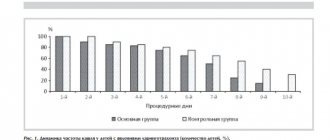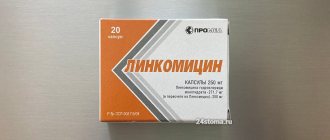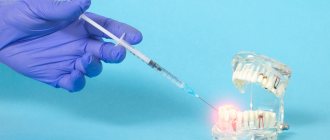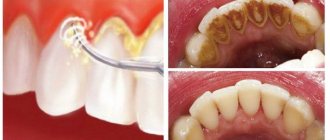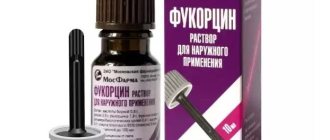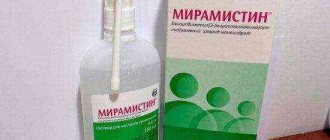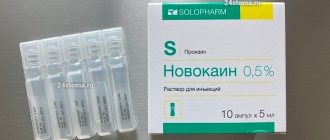Local therapy for pharyngitis
According to the etiological factor, acute pharyngitis can be divided into viral, bacterial, fungal, allergic, traumatic (as a result of a foreign body or surgical intervention) and caused by exposure to irritating factors (hot liquid or steam, acids, alkalis, radiation, etc.). Chronic pharyngitis is usually classified not according to etiology, but according to the nature of the changes developing in the mucous membrane: catarrhal (simple), atrophic (subatrophic) and hypertrophic. The most common form of acute inflammation of the pharyngeal mucosa is catarrhal pharyngitis during ARVI. It is known that approximately 70% of pharyngitis is caused by viruses, including rhinoviruses, coronaviruses, respiratory syncytial virus, adenovirus, influenza and parainfluenza viruses. The most common causative agent of acute pharyngitis is rhinoviruses. Research in recent years shows that their importance is growing rapidly, and now rhinoviruses are responsible for more than 80% of acute respiratory viral infections during autumn epidemics. Viral infection is often only the first phase of the disease, and it “paves the way” for subsequent bacterial infection. Chronic pharyngitis is a polyetiological disease, in the genesis of which numerous factors play a role, but the cause of exacerbation of the inflammatory process in the pharynx is most often the influence of microorganisms [3,6,9]. The conclusion is substantiated that infection plays a major role not in the occurrence, but in the chronicity of pharyngitis [1]. The main causative agents of chronic pharyngitis are: Streptococcus α–haemolyticus (107–109 CFU), β–haemolyticus (104–108 CFU), γ–haemolyticus (108–109 CFU); Staphylococcus aureus (105–108); CNS Staphylococcus (106–108); Neisseria spp. (105–107); Haemophilus spp. (103–105); Corynebacterium spp. (104–105); fungi of the genus Candida (105–108); filamentous fungi (up to continuous growth) [3]. Irrational antibiotic therapy leads to persistent dysbiotic changes in the mucous membrane of the oropharynx, immunosuppression and antibiotic resistance. When examining patients with a long and persistent history of the disease, the fungal nature of inflammation is detected in 44.7% of patients. In 90% of cases, the bacterial flora of the posterior pharyngeal wall is represented by associations of 2-3 types of microbes. At the same time, studies by a number of authors have established that the normal microflora of the oral cavity and pharynx in healthy individuals is characterized by a certain constancy. It has been established that the primary penetration of bacteria into the oral cavity occurs during the passage of the fetus through the birth canal; the initial microflora is represented by lactobacilli, enterobacteria, corynebacteria, staphylococci and micrococci, but after 2–7 days it is almost completely replaced by bacteria living in the oral cavity of the mother and maternity ward staff [10]. However, it should be taken into account that the polymorphism of bacterial contamination of the mucous membrane does not provide grounds to associate the occurrence and course of this disease with any one type of microbe. It should also be noted that the bacterial flora is represented exclusively by opportunistic bacteria that are capable of exhibiting virulence only under conditions of reduced general or local resistance of the body. This makes it possible to think that in the pathogenesis of pharyngitis, the microbial flora does not play the role of a leading and determining factor, but a violation of the protective mechanisms of the mucous membrane is of paramount importance [2]. There is evidence in the literature that in older people there is a natural change in the species composition of the microbial flora of the oropharynx. At the same time, the representation of microorganisms such as Staphylococcus aureus and aerobic gram-negative enterobacteria increases. But the reason for these changes is still not entirely clear [13]. Chronic pharyngitis is often a consequence of acute pharyngitis. Risk factors for the development of chronic pharyngitis and a possible cause of the disease may be foci of chronic infection in the pharynx, oral cavity, nose, and paranasal sinuses [14]. Despite the obvious significance of infection, there are many reasons to believe that the body’s defenses play a major role in the genesis of pharyngitis. This conclusion was made based on the ineffectiveness (in many cases) of antibiotic therapy [18]. The first line of defense for the mucous membranes is the innate immune system. It is represented by many soluble factors (molecules) found in saliva and other secretions that protect mucous membranes, as well as certain types of leukocytes. Both soluble factors and innate immune cells recognize characteristic microbial substrates: lipopolysaccharides (LPS) of gram-negative bacteria, peptidoglycan and lipoteichoic acids of gram-positive microbes, mannose, bacterial DNA, N-formylmethionine, double-stranded RNA of viruses, glycans of fungal cell walls, and much more. [12]. The innate immune system comes into play immediately, but its capabilities are limited: it can recognize only about 1000 structures [17]. The innate immune system includes cellular and humoral factors. Humoral factors of innate immunity are present in mucus, saliva, secretions, blood plasma and tissue fluid, and many directly recognize and bind pathogen antigens. This group includes, among others, bactericidal factors, lysozyme and defensins, which cause lysis of microbes [5]. The clinical picture of acute pharyngitis is characterized by soreness, dryness, discomfort and pain in the throat when swallowing (especially with an empty throat), less often - general malaise, and a rise in temperature. When the tubar ridges become inflamed, the pain usually radiates to the ears. On palpation, there may be pain and enlargement of the upper cervical lymph nodes. Pharyngoscopy reveals hyperemia of the posterior wall of the pharynx and palatine arches, individual inflamed lymphoid granules, but there are no signs of inflammation of the tonsils characteristic of angina. The clinical picture of chronic pharyngitis is not characterized by an increase in temperature and a significant deterioration in general condition. The sensations are characterized by patients as dryness, soreness and a feeling of a lump in the throat, which causes a desire to cough. The cough is usually persistent, dry and easily distinguishable from the cough that accompanies the course of tracheobronchitis. Discomfort in the throat is often associated with the forced need to constantly swallow mucus in the back of the throat, which makes patients irritable, interferes with their normal activities and disrupts sleep. Consideration of issues of therapeutic measures for chronic pharyngitis should be determined by the main pathogenetic mechanisms of the disease. First of all, it is recommended to eliminate those pathological conditions that were the cause of chronic inflammation of the pharynx. Sanitation of the nasal cavity and paranasal sinuses, restoration of normal nasal breathing, conservative and, if necessary, surgical treatment of chronic tonsillitis, elimination of unfavorable production or household factors often make it possible to achieve a positive result without additional therapeutic effects on the pharyngeal mucosa. A diet is indicated - it should completely exclude the intake of irritating foods (hot, cold, sour, spicy and salty). In case of acute and exacerbation of chronic pharyngitis, not accompanied by pronounced disorders of the general condition, symptomatic treatment is sufficient, including a gentle diet, hot foot baths, warm compresses on the front surface of the neck, milk with honey, steam inhalations and gargling. Smoking should be stopped. Uncomplicated pharyngitis usually does not require systemic antibiotics. In this situation, it becomes justified to carry out not systemic, but local antimicrobial therapy, which can also be prescribed in the form of monotherapy. In the local treatment of exacerbation of chronic pharyngitis, various methods are used: rinsing, lubricating, inhalation with the use of various medications that have anti-inflammatory, antimicrobial, antiallergic, astringent and emollient effects. Blockades, cauterization, and physiotherapy are used. All existing methods of treating chronic pharyngitis can be divided into two directions - conservative and surgical. Physiotherapeutic methods such as UV irradiation, medicinal electrophoresis, phonophoresis of the pharynx, microwave and ultrasound therapy, diathermy of the area of the neurovascular bundles of the neck, darsonvalization of the posterior surface of the neck, and diadynamic current are widely used in the treatment of chronic pharyngitis. There are many modern medications for local action on the pharyngeal mucosa, and this makes it possible to choose the optimal treatment method. However, this choice is sometimes difficult due to the existence of drugs that have similar effects. It remains relevant to study the characteristics of the action of individual drugs in various nosological forms [7–11,15]. The creation of effective drugs of combined action for local use in the pharynx is an urgent task. The importance of lysozyme in protection against chronic pharyngitis is indicated by the work of A.A. Egorov [4], who proposed treating patients with lysozyme preparations. The effect of enhancing the action of antiseptic drugs in the presence of lysozyme was also noted. All medications used for local treatment of pharyngitis can be divided into 6 groups: local antibiotics, antiseptics, local antimycotics, immunocorrectors, local anesthetic and anti-inflammatory drugs, homeopathic remedies (Table 1). As you know, an antibiotic destroys microbial flora. But nature abhors a vacuum, and mushrooms take the place of microbes, especially against the background of reduced immunity. Therefore, the prescription of antiseptics, i.e. drugs that kill “every living thing”, incl. and mushrooms, allows you to solve this problem. But the abuse of antiseptics, in turn, leads to the death of the surface layer of the epithelium lining the pharynx, which in itself increases the patient’s discomfort. Local anti-inflammatory drugs usually include one or more antiseptics (chlorhexidine, hexetidine, benzydamine, ambazone, thymol and its derivatives, alcohols, iodine preparations, etc.), essential oils, local anesthetics (lidocaine, tetracaine, menthol), less often - antibiotics (fusafyungin, framycetin) or sulfonamides, deodorizing agents. Preparations may also contain bacterial lysates, natural antiseptics (plant extracts, bee products), synthesized factors of nonspecific protection of mucous membranes, which also have an antiviral effect (lysozyme, interferon), vitamins (ascorbic acid). Antimicrobial drugs can be prescribed in the form of rinses, insufflations, inhalations, as well as tablets and lozenges. The main requirements for drugs applied to the mucous membrane are: • a wide spectrum of antimicrobial action, preferably including antiviral and antimicrobial activity; • lack of toxic effect and low rate of absorption from mucous membranes; • low allergenicity; • no irritating effect on the mucous membrane. Most drugs (Hexalize, Drill, Septolete, Faringosept, Neoangin, Strepsils, etc.) for the treatment of pharyngitis are available in the form of tablets, lozenges or lozenges. This form of drugs has relatively low activity, and their use is limited to mild forms of the disease. In addition, the doctor should remember the toxicity of chlorhexidine, which is part of many drugs (Antiangin, Drill, Sebidine, Eludril) and should not allow their unlimited, uncontrolled use by patients (especially children). The prescription of a number of drugs is limited by their high allergenicity and irritating effect. This includes drugs containing iodine derivatives (iodinol, iox, vocadine, povidone-iodine), propolis (proposol), sulfonamides (bicarmint, ingalipt). Preparations containing herbal antiseptics and essential oils are effective and harmless, but their use is contraindicated in patients suffering from allergies to pollen, and the number of people with this disease in some geographic areas is up to 20% of the population. Pregnant and lactating women can use lysobact, which contains lysozyme together with vitamin B6. It is an antibacterial agent, an enzyme of the hydrolase class that destroys the cell membranes of bacteria by lysing the cell membrane of gram-positive and gram-negative bacteria and fungi, and also has antiviral activity. We will focus only on those tools that are regularly used in our practice and the effectiveness of which has been confirmed by our own experience. Terasil is used for infections of the mouth and throat - sore throat caused by an irritating cough and colds, and contains amylmetacresol and 2,4-dichlorobenzyl alcohol, as well as excipients: sucrose, liquid glucose, purified water, sodium chloride, sodium sucrose, citric acid (anhydrous), sunset yellow, menthol, eucalyptus oil. All components of the drug are quickly absorbed and quickly eliminated. The metabolite of 2,4-dichlorobenzyl alcohol is 2,4-dichlorobenzoic acid, which is excreted by the kidneys as an acid or as a glycine compound. Amylmetacresol is oxidized to acid and excreted through the kidneys as a glucuronide. Terasil lozenges (formula for sore throat) are used to effectively influence gram-positive and gram-negative bacteria that cause diseases of the oral cavity and pharynx, as well as fungi and yeast. 2,4-dichlorobenzyl alcohol and amylmetacresol, which are part of the lollipops, have disinfectant and antiseptic properties, which allows them to be used to treat infections of the throat and oral cavity. 2,4-dichlorobenzyl alcohol is a benzene derivative, amylmetacresol is a phenol derivative. The main effect of 2,4-dichlorobenzyl alcohol and amylmetacresol is due to activity on the surface of the pharyngeal mucosa; both substances interact with cell membrane lipids, which explains their effectiveness against bacteria and fungi. Terasil (formula for sore throat) also has a soothing effect. Thanks to the properties described above, this drug eliminates and alleviates the symptoms of inflammatory infections of the mouth and throat, is well tolerated and has a pleasant taste. Application: dissolve one lozenge slowly every 2–3 hours (no more than 12 lozenges per day). Strepsils, which contains 2,4-dichlorobenzyl alcohol and amylmetacresol 0.6 mg, has a similar effect and composition. There are 5 versions of Strepsils with various additives (with anise and peppermint oils, with honey and lemon, with menthol and eucalyptus, with vitamin C, with lemon and herbs, without sugar). Strepsils is an antiseptic, anticongestive (decongestant) agent. Strepsils is a combination drug for topical use in ENT practice and dentistry. Active against a wide range of gram-positive and gram-negative microorganisms in vitro; has an antifungal effect. Natural medicinal additives included in the preparation have a softening and decongesting effect on the mucous membrane. An overdose may cause discomfort in the gastrointestinal tract. It is possible to use Strepsils during pregnancy and lactation (according to indications). In case of severe pain in the throat, it is possible to use Strepsils Plus lozenges or spray, since, in addition to 2,4-dichlorobenzyl-ethanol and amylmetacresol, this drug contains lidocaine hydrochloride. The drug is contraindicated in children under 12 years of age. The use of Strepsils Plus during pregnancy and lactation is possible only according to indications. Cough is one of the most common reasons for visiting a doctor. This is one of the symptoms that often bothers patients with inflammatory pathology of the pharynx. Due to the peculiarities of the localization of cough receptors, the symptom of cough is often accompanied by a variety of diseases, but its most common cause, of course, is diseases of the upper and lower respiratory tract and, in particular, pharyngitis. The inflammatory process in the respiratory tract (regardless of its location) is always accompanied by symptoms of discrinia, that is, a violation of mucus formation, rheological properties and transport of secretions from the upper and lower respiratory tract. In this regard, in the complex treatment of inflammation in the pharynx, it is advisable to prescribe systemic mucoregulators - drugs, the primary effect of which is to restore the rheological parameters of secretion of the mucous membrane of the respiratory tract due to the effect on goblet cells of the epithelium (Table 2). Travisil (lozenges) belongs to a group of combination drugs for the treatment of coughs and colds. Travisil is used for infectious diseases of the upper respiratory tract (bronchitis, pharyngitis, tonsillitis), asthmatic cough, diseases of the oral cavity and smoker's cough. Travisil has a pronounced expectorant, antiseptic, anti-inflammatory and deodorizing effect on the oral cavity due to its multicomponent composition of plant origin. Adatoda vasika has a strong expectorant, bronchodilator and antihistamine effect. Long-fruited pepper has an expectorant and mucolytic effect. Black pepper has a strong expectorant and anti-inflammatory effect, and has a deodorizing effect in the oral cavity. Zingiber officinalis has anti-inflammatory and antitussive effects. Licorice glabra reduces cough irritation and has an expectorant and diaphoretic effect. Emblica officinalis is a strong antitussive, has anti-inflammatory, immunomodulatory and restorative effects, contains vitamin C. Turmeric Longa has anti-inflammatory and antihistamine effects. Acacia Katehu has an antihistamine and astringent effect, refreshes the oral cavity. Common fennel has an expectorant and antitussive effect, soothes sore throats, and improves the functions of the gastrointestinal tract. Basil has a strong antitussive, expectorant, antipyretic and analgesic effect. Terminalia Chebula has an antihistamine, antimicrobial and antitussive effect. Terminalia Belerica has a pronounced antitussive and immunomodulatory effect. Large galangal has a strong anti-cold and anti-tussive effect. Hekveriti has anti-inflammatory and antihistamine effects. Menthol is an effective antiseptic and expectorant, deodorizes and refreshes the oral cavity. Travisil is used for dry and wet cough of bacterial and viral etiology by adults, 2-3 lozenges 3 times a day. Possible side effects due to an allergic reaction (skin rash, itching). Travisil is contraindicated in children under 6 years of age. In conclusion, we can say that topical antibacterial agents can be widely used in the treatment of pharyngitis. The choice of the optimal drug is determined by the spectrum of its antimicrobial activity, the absence of allergenicity and toxic effect. Of course, the most effective local drugs will not completely replace the need for systemic administration of antibiotics for sore throat and pharyngitis caused by β-hemolytic streptococcus. On the other hand, due to the nonbacterial etiology of many forms of pharyngitis, the emergence of an increasing number of resistant strains of bacteria, as well as the undesirable effects of general antibiotic therapy, local administration of drugs with a broad spectrum of antimicrobial activity is in many cases the method of choice.
Literature 1. Bakanova D.L., Grig M.G., Dykhno M.M. Antibiotics. –1976. – T.21. – No. 11. – P.988–992. 2. Grafskaya N.A. Correction of microbial imbalance of the pharynx in chronic pharyngitis. News of otorhinolaryngology and logopathology. –2002.–No. 1.–e. 6–8. 3. Gurov A.V., Luchikhin L.A., Polyakova T.S. Vestn. otorhinol. 2007;3:56–58. 4. Egorov A.A. Materials for the meeting. problems. Commission on Otorhinolaryngology of the Scientific Medical Council of the RSFSR and the Republic. scientific-practical conf. otorhinolaryngologists. Abstract message – M., 1980. – P.34–36. 5. Kokryakov V.N. Biology of antibiotics of animal origin. - St. Petersburg: Nauka, 1999. - 162 p. 6. Kryukov A.I., Sedinkin A.A. Materials of the Russian Conference of Otorhinolaryngologists. M, 2002; 362 – 363. 7. Luchikhin L.A., Belyakova L.V., Vasiliev R.A. Vestn. otorhinol. 2006; 4: 53 – 56. 8. Ovchinnikov A.Yu., Svistushkin V.M., Nikiforova G.N. Vestn. otorhinol. 2005; 5: 273 – 274 (Appendix). 9. Ovchinnikov Yu.M., Levin A.M., Fitilev S.B. Attending doctor. 2000; 4: 2–5. 10. Pokrovsky V.I., Pozdeev OK Medical microbiology. Educational literature for medical students. Universities. –M. – 1999. – 1184 p. 11. Pluzhnikov M.S., Lavrenova G.V. and others. Chronic tonsillitis. Clinic and immunological aspects. St. Petersburg. 2005; 206. 12. Pluzhnikov M.S., Panova N.V., Levin M.Ya., Lavrenova G.V., Afanasyeva I.A. Pharyngitis (clinical and morphological aspects and cryosurgery) / ed. M.S. Pluzhnikova – St. Petersburg: Dialog, 2006. – 120 p. 13. Svistushkin V.M. Inflammatory diseases of the upper respiratory tract in older people: features of development and drug treatment. Consilium medicum. – 2003. – vol. 5. – No. 12. – p. 686–690. 14. Soldatov I.B. Pharynx. In the book: Guide to otorhinolaryngology. – M., 1994. – P.283–305. 15. Tarasova G.D. Vestn. otorhinol. 2005; 5: 335 – 336 (Appendix). 16. Khamzalieva R.B. Vestn. otorhinol. 2007; 2:28–29. 17. Medzhitov R., Janeway S. Science. - 2002. - Vol. 296. - P.298–300. 18. Orrling A., Karlsson E., Melhus A. et al. Ann. Otol., Rind., Laryngol. – 2001. – 110 (7). – P.690–5.
Fukortsin 10ml solution for external use
pharmachologic effect
Antiseptic.
Composition and release form Fukortsin 10ml solution for external use
Solution - 100 ml:
- Active ingredients: boric acid 0.8 g, basic fuchsin dye 0.4 g, phenol 3.9 g, resorcinol 7.8 g;
- excipients: acetone 4.9 g, ethanol 95% 9.6 ml, purified water up to 100 ml.
10, 15 or 25 ml in orange glass bottles with a screw neck, sealed with polyethylene stoppers with screw-on caps, or sealed with screw-on caps with sealing elements, or sealed with polyethylene threaded caps (with a sealing element and a brush), or in polymer bottles, sealed with stoppers polymer or stoppers with sealing elements and polymer caps, or 10, 15, 25 ml in orange glass dropper bottles, sealed with stoppers with sealing elements, dropper stoppers and screw-on caps, sealed with caps and polymer stoppers or capped with screw-on caps.
10, 15, 25 ml in polymer bottles complete with a cap and dispenser or in polymer bottles with screw caps and dropper stoppers or 10, 15, 25 ml in polymer dropper bottles, 10, 15 ml in dropper bottles polymer, complete with screw caps and dropper plugs.
Each bottle (dropper bottle), along with instructions for use, is placed in a cardboard pack or sealed in a plastic bag. It is allowed to pack bottles (drip bottles) together with an equal number of instructions for use in a group package (cardboard box).
Description of the dosage form
The liquid is dark red in color with a characteristic smell of phenol.
Directions for use and doses
Externally. The solution is applied using a tampon or glass rod to the affected areas of the skin 2-4 times a day. After the liquid has dried, ointments and pastes can be applied to the treated area.
There is no information about the effects of the drug upon first use or upon its withdrawal.
Indication of the possibility and features of medical use of the drug in children and adults with chronic diseases is not available.
Pharmacodynamics
Has antiseptic and antifungal effects.
Indications for use Fukortsin 10ml solution for external use
Pustular and fungal skin diseases, superficial wounds, erosions, cracks, skin abrasions.
Contraindications
Hypersensitivity to the components of the drug.
Application of Fukortsin 10ml solution for external use during pregnancy and breastfeeding
It is not recommended for use by women during pregnancy and breastfeeding.
special instructions
The drug should not be applied to large areas of the skin, since the phenol contained in the drug can penetrate into the blood and cause toxic effects (dizziness, weakness).
The drug has a peculiar odor and red color and can stain laundry.
Impact on the ability to drive vehicles and operate machinery
No information available.
Overdose
With prolonged use of fucorcin and its use on large areas of the skin, an overdose of the drug is possible, which is accompanied by phenomena characteristic of phenol poisoning (dizziness, weakness, breathing problems). If such phenomena occur, it is necessary to give the patient access to fresh air and carry out symptomatic treatment.
Side effects of Fukortsin 10ml solution for external use
Local reactions; It is possible (especially in children) to experience a burning sensation and pain, which goes away on its own and does not require discontinuation of the drug.
Drug interactions
Interaction with other drugs is unknown.

